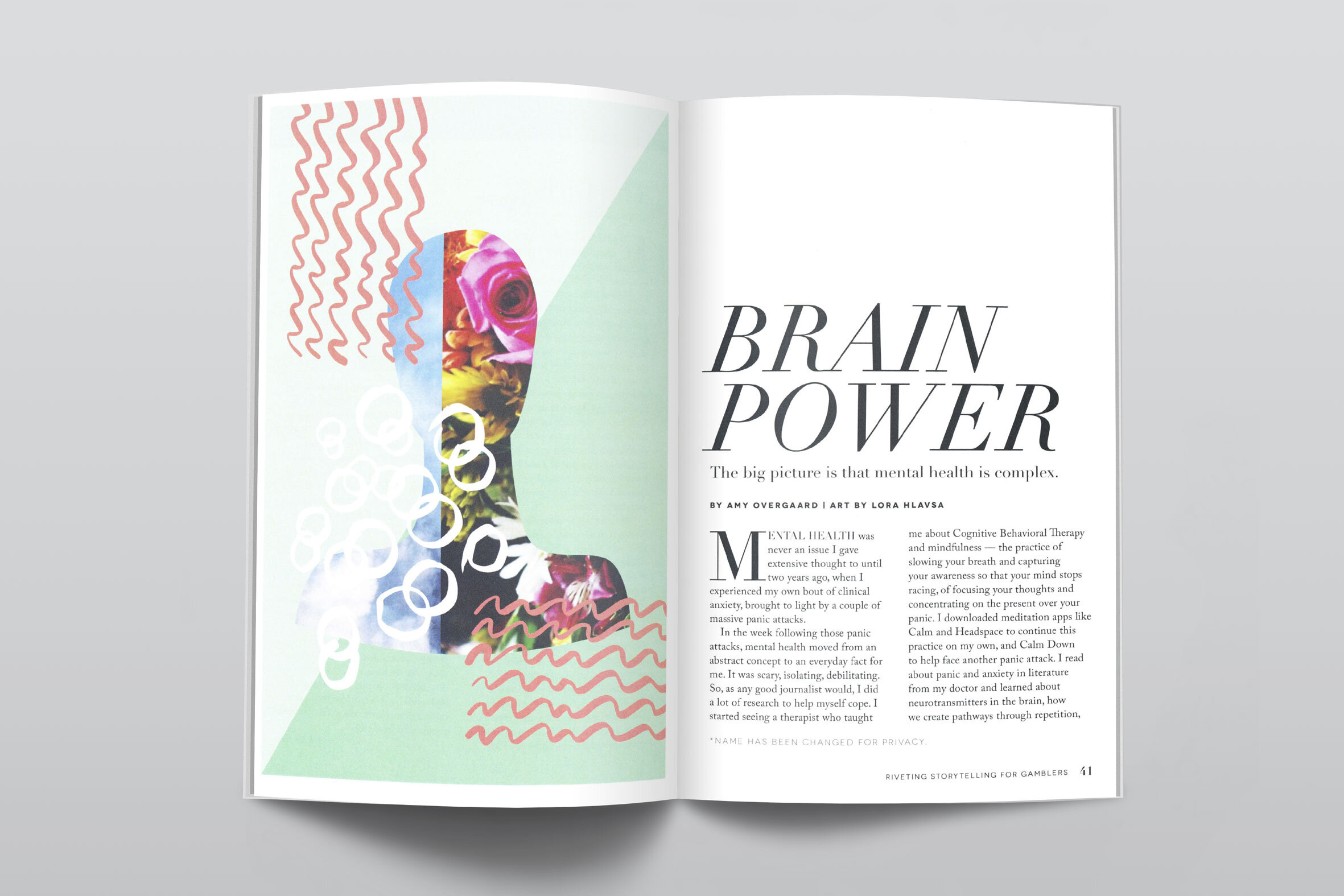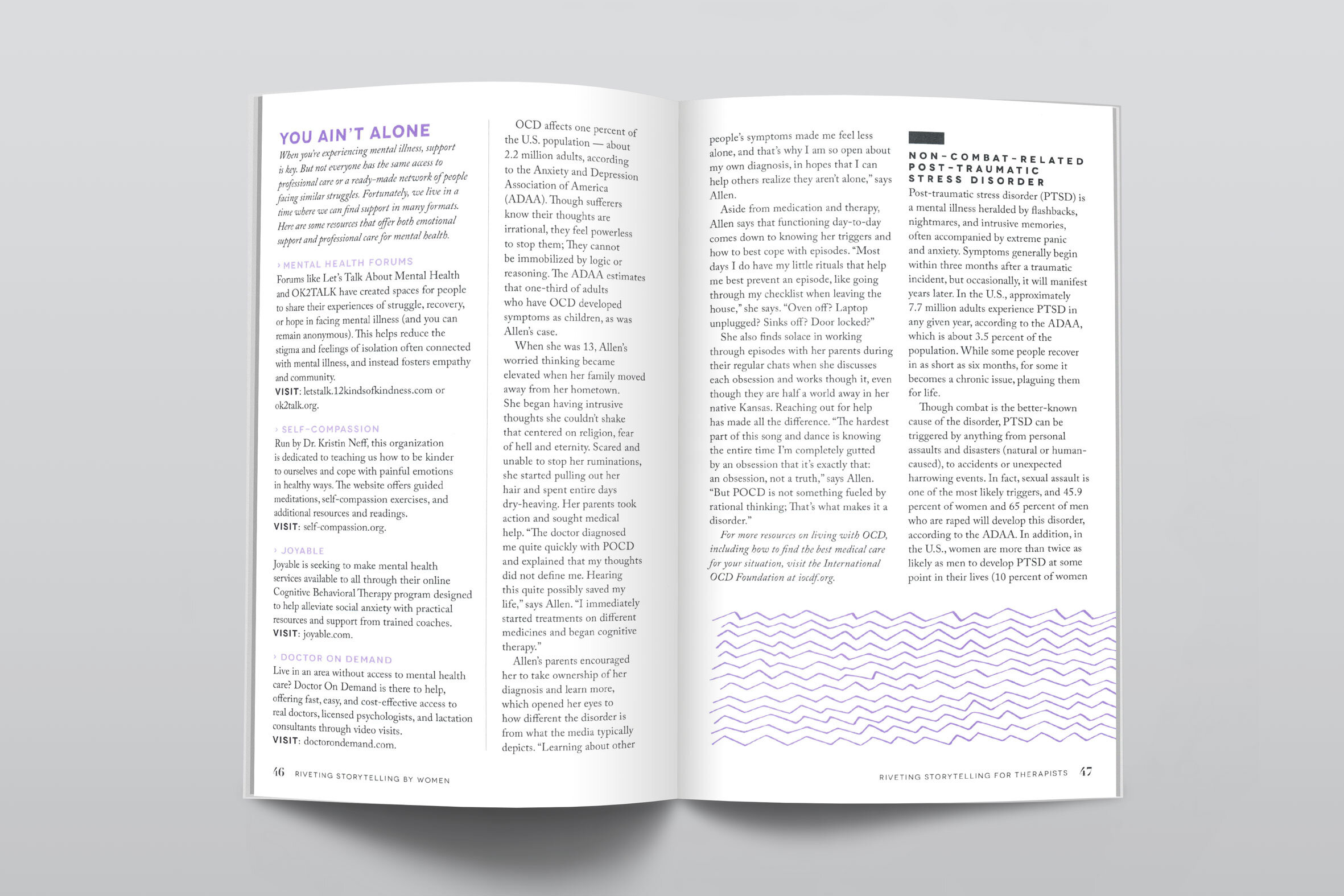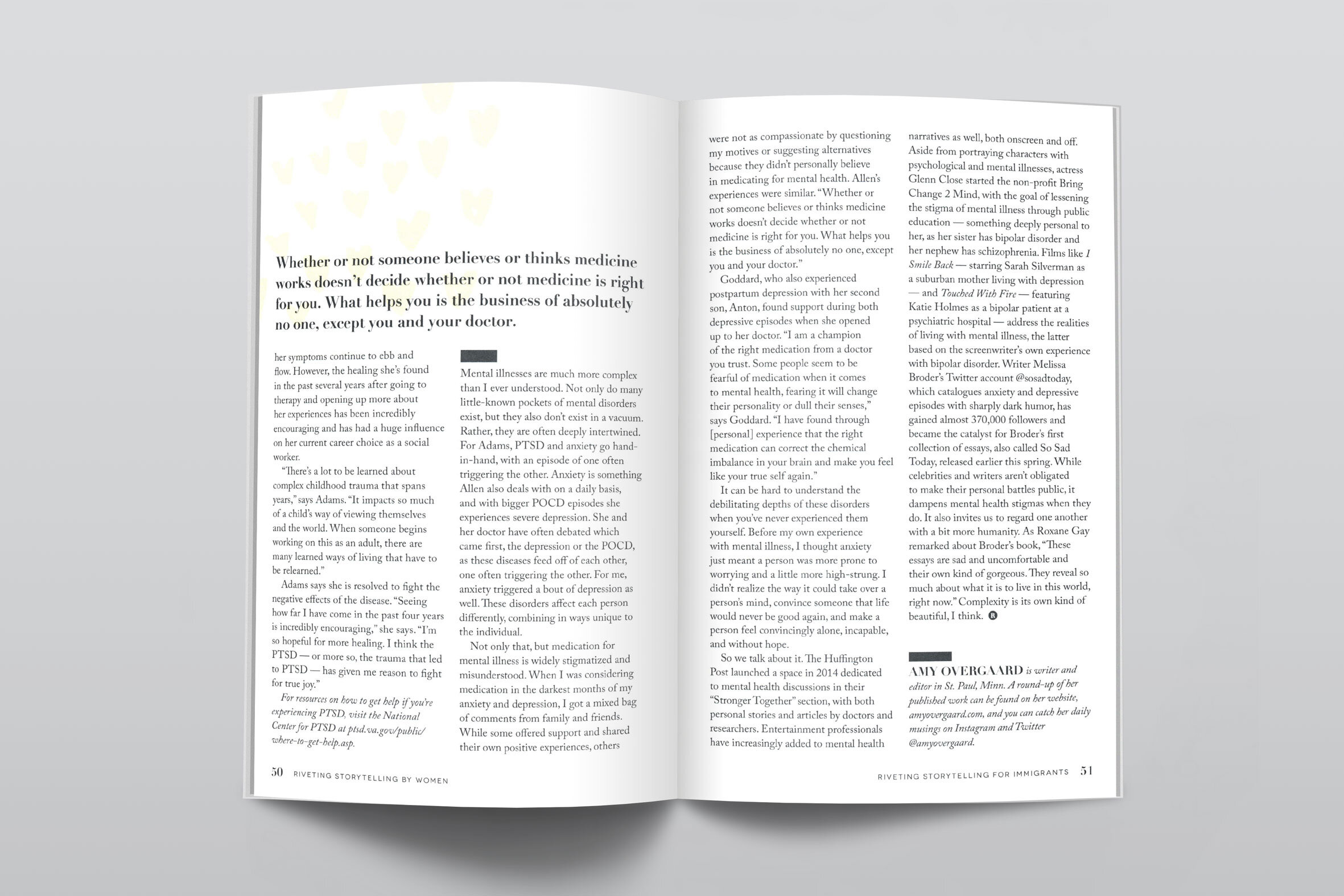Brain Power
The riveter, summer 2016
Brain Power
Mental health was never an issue I gave extensive thought to until two years ago, when I experienced my own bout of clinical anxiety brought to light by a couple of massive panic attacks.
In the week following those panic attacks, mental health moved from an abstract concept to an everyday fact for me. It was scary, isolating, debilitating. So, as any good journalist would, I did a lot of research to help myself cope. I started seeing a therapist who taught me about Cognitive Behavioral Therapy and mindfulness — the practice of slowing your breath and capturing your awareness so that your mind stops racing, of focusing your thoughts and concentrating on the present over your panic. I downloaded meditation apps like Calm and Headspace to continue this practice on my own, and Calm Down to help face another panic attack. I read about panic and anxiety in literature from my doctor and learned about neurotransmitters in the brain, how we create pathways through repetition, and discovered lifestyle changes to cope with and alleviate anxiety. I talked to my doctor about medication versus natural remedies and what was right for my situation. Throughout all of this, I discovered that approximately one in five adults in the U.S. experience some kind of mental illness — that's nearly 44 million adults, according to the 2014 National Survey on Drug Use and Health (NSDUH), an annual study conducted by the U. S. Department of Health and Human Services — and yet, collectively we tip-toe around the subject of mental health as if it's something we'll catch by saying it too loudly.
So I started talking about it. I talked about it so I didn’t feel so alone, so that the panic had less power. I listened so that I knew other people had been on this path and that it didn’t stop them from living. In hearing other people's experiences with mental illness, I discovered that there was so much I didn’t know about the subject. And I realized there are still certain mental health disorders that, as a society we are less willing to talk about than others — whether that’s from a lack of extensive scientific research and social understanding, the rareness of some disorders, or simply because those experiencing lesser-known disorders have kept their experiences private.
Beyond anxiety, bipolar disorder and depression are disorders with just as much destructive power but maybe not as much public understanding. I spoke with three individuals who experience lesser known disorders — including a specific type of postpartum depression, a subset of the more widely known obsessive-compulsive disorder, and non-combat-related post-traumatic stress disorder — in order to glean insight into disorders that aren't given mainstream airtime.
WEANING-RELATEd POSTPARTUM DEPRESSION
Postpartum depression (PPD) affects an average of 15 percent of women who give birth each year, according to the Centers for Disease Control and Prevention — that's at least 950,000 women a year. (However, this number is estimated to be much higher by Postpartum Progress, a non-profit that offers support and raises awareness for women with maternal metal illnesses, as many women don’t seek help for their PPD or don’t even realize that's what they're dealing with.) An even smaller percentage experience the effects ofPPD in relation to weaning, an area with very little research surrounding it. In fact, in researching this subject, I found very little scholarly material related to this specific facet of PPD — but countless forums and blogs where real mothers were sharing their experiences and asking for advice, displaying its prevalence.
Joanna Goddard, a 37-year-old writer who runs the lifestyle blog A Cup of Jo, first opened my eyes to lesser-known iterations of more common mental health disorders. Four years ago Joanna wrote a post called "The Hardest Two Months of My Life," in which she talked about the extreme depression she experienced eight months after her first son, Toby, was born, shortly after she weaned him. "Out of nowhere, my mind started obsessing and worrying about inconsequential things; I had trouble sleeping; I began feeling very down. Why? I had no idea," wrote Goddard.
She began to tailspin. Even though she felt she had "a great life on paper," taking care ofToby suddenly seemed inexplicably exhausting. During that time, she believed she was a terrible mother and worried that her career was ending and that her husband or friends would get sick of her. She shared her feelings with her husband, her mother and a therapist, plus she exercised — but the feelings she struggled with persisted. "Life felt really, really dark," she says.
But then, after two months of struggling, she woke up one day and felt like herself again. "It felt like I had been swimming in a pool, and suddenly — whoosh! — I had resurfaced and my head had come back out of the water, and I could see the bright sun and breathe in the fresh air again. It felt like waking up from a bad dream," she wrote in her blog post. The next day, she got her period for the first time since getting pregnant with Toby. In hindsight, she realized her dark depression had been related to the fact that she had quickly weaned Toby from breastfeeding — the weaning happened within a week, which led to a hormone crash.
Kelly Bonyata, international board-certified lactation consultant and the voice behind kellymom.com, a website on parenting and breastfeeding, writes that the drop in prolactin and oxytocin levels is directly associated with weaning-related postpartum depression. Prolactin and oxytocin are hormones required for milk production and ejection, respectively, and they bring with them feelings of calmness, well-being, and relaxation. The faster the weaning process, the more likely a mother will experience adverse emotional effects due to the rapid shift in hormone levels. There is no fixed timeline for how long mothers should take to wean — it more depends on the physical and emotional comfort of both mother and baby — but when possible, the Mayo Clinic recommends taking anywhere from several weeks to several months, slowly tapering off how long and often one breastfeeds each day, so milk supply gradually diminishes. Goddard notes that postpartum depression, often rooted in hormonal imbalances, isn't something you can prevent by being proactive. "People don’t always see [depression] as a real physical illness, especially if everything in your life seems to be good, and instead assume it's just a bad day, and you should just get over it and cheer up," she says. "It is a very serious illness that needs to be treated as such."
For more information and resources regarding postpartum disorders, visit Postpartum Support International at postpartum.net.
primarily obsessional obsessive-compulsive disorder
Anna Allen is a27-year-old copywriter living in Hamburg, Germany, who experiences a little-known iteration of obsessive-compulsive disorder (OCD): primarily obsessional obsessive-compulsive disorder (POCD). POCD doesn’t necessarily have all of the outward compulsions traditionally associated with OCD — namely, the ritualized behaviors. Rather, it's generally internal, resulting in intrusive thoughts and irrational, uncontrollable fears.
"Since a young age, like 3 or 4, I have experienced irrational ruminations that would last for days or even weeks, sometimes even months," says Allen. "Nowadays they mostly have to do with worries as menial as whether or not I left my sink running. I spent an entire trip to Sweden having panic attacks that I would come home to a flooded apartment, though this would have been impossible had the sink even been on."
OCD affects one percent of the U.S. population — about 2.2 million adults, according to the Anxiety and Depression Association of America (ADAA). Though sufferers know their thoughts are irrational, they feel powerless to stop them; they cannot be immobilized by logic or reasoning. The ADAA estimates that one-third of adults who have OCD developed symptoms as children, as was Allen's case.
When she was 13, Allens worried thinking became elevated when her family moved away from her hometown. She began having intrusive thoughts she couldn't shake that centered on religion, fear of hell, and eternity. Scared and unable to stop her ruminations, she started pulling out her hair and spent entire days dry-heaving. Her parents took action and sought medical help. "The doctor diagnosed me quite quickly with POCD and explained that my thoughts did not define me. Hearing this quite possibly saved my life," says Allen. "I immediately started treatments on different medicines and began cognitive therapy."
Allen’s parents encouraged her to take ownership of her diagnosis and learn more, which opened her eyes to how different the disorder is from what the media typically depicts. "Learning about other people's symptoms made me feel less alone, and that's why I am so open about my own diagnosis, in hopes that I can help others realize they aren’t alone," says Allen.
Aside from medication and therapy, Allen says that functioning day-to-day comes down to knowing her triggers and how to best cope with episodes. "Most days I do have my little rituals that help me best prevent an episode, like going through my checklist when leaving the house," she says. "Oven off? Laptop unplugged? Sinks off? Door locked?"
She also finds solace in working through episodes with her parents during their regular chats when she discusses each obsession and works though it, even though they are half a world away in her native Kansas. Reaching out for help has made all the difference. "The hardest part of this song and dance is knowing the entire time I'm completely gutted by an obsession that it's exactly that: an obsession, not a truth," says Allen. "But POCD is not something fueled by rational thinking; that's what makes it a disorder."
For more resources on living with OCD, including how to find the best medical care for your situation, visit the International OCD Foundation at iocdf.org.
non-combat-related post-traumatic stress disorder
Post-traumatic stress disorder (PTSD) is a mental illness heralded by flashbacks, nightmares, and intrusive memories, often accompanied by extreme panic and anxiety. Symptoms generally begin within three months after a traumatic incident, but occasionally, it will manifest years later. In the U.S., approximately 7.7 million adults experience PTSD in any given year, according to the ADAA, which is about 3.5 percent of the population. While some people recover in as short as six months, for some it becomes a chronic issue, plaguing them for life.
Though combat is the better-known cause of the disorder, PTSD can be triggered by anything from personal assaults and disasters (natural or human-caused), to accidents or unexpected harrowing events. In fact, sexual assault is one of the most likely triggers, and 45.9 percent of women and 65 percent of men who are raped will develop this disorder, according to the ADAA. In addition, in the U.S., women are more than twice as likely as men to develop PTSD at some point in their lives (10 percent of women versus 4 percent of men), according to the National Center for PTSD.
Brie Adams*, a 25-year-old social worker in Minneapolis, developed PTSD after being sexually abused by her stepdad as a child. "My mom got remarried to my stepdad when I was seven years old. He lived with us until he went to jail when I was 15," she says. "During those eight years, he was sexually, physically, and emotionally abusive to me."
Emotional numbing and dissociation — a disconnection from reality in a person's thoughts, memory, or sense of identity according to Mental Health America — are also major symptoms that Adams faces today as a result of her PTSD. "There are large [portions] of my childhood that I don’t remember and pieces of traumatic memories that I still remember in fragments," she says. "When I get really anxious or re-experience a trigger, I shut down and revert to how I would have responded to this trauma when it happened in childhood."
Adams says that, growing up, not many people around her were educated about childhood PTSD, so it wasn't until she was in college that she began receiving counseling to work through her childhood trauma. "All of the signs and patterns were there in my childhood, but I think I did a good job of hiding it until college," says Adams, as most of her symptoms were more internal — extreme anxiety, flashbacks, nightmares, dissociation. It wasn't until she started spending time with a mentor and other adults with healthy patterns that she "learned that a lot of my behaviors and fears were not normal."
Aside from traditional therapy, Adams has undergone Eye Movement Desensitization and Reprocessing therapy, which she says involves "bilateral stimulation through vibrations or eye movements during a therapy session that ... focuses on processing specific traumatic events."
"The goal is to essentially restore this information in a way that is less harmful — to attach new meanings to it and then store it in a way that [gives it] closure," she says. Though this type of therapy has been instrumental in coping with her PTSD, her symptoms continue to ebb and flow. However, the healing she's found in the past several years after going to therapy and opening up more about her experiences has been incredibly encouraging and has had a huge influence on her current career choice as a social worker.
"There's a lot to be learned about complex childhood trauma that spans years," says Adams. "It impacts so much of a child's way of viewing themselves and the world. When someone begins working on this as an adult, there are many learned ways of living that have to be relearned."
Adams says she is resolved to fight the negative effects of the disease. "Seeing how far I have come in the past four years is incredibly encouraging," she says. "I'm so hopeful for more healing. I think the PTSD — or more so, the trauma that led to PTSD — has given me reason to fight for true joy."
For resources on how to get help if you’re experiencing PTSD, visit the National Center for PTSD at ptsd.va.gov.
Mental illnesses are much more complex than I ever understood. Not only do many little-known pockets of mental disorders exist, but they also don’t exist in a vacuum. Rather, they are often deeply intertwined. For Adams, PTSD and anxiety go hand-in-hand, with an episode of one often triggering the other. Anxiety is something Allen also deals with on a daily basis, and with bigger POCD episodes she experiences severe depression. She and her doctor have often debated which came first, the depression or the POCD, as these diseases feed off of each other, one often triggering the other. For me, anxiety triggered a bout of depression as well. These disorders affect each person differently, combining in ways unique to the individual.
Not only that, but medication for mental illness is widely stigmatized and misunderstood. When I was considering medication in the darkest months of my anxiety and depression, I got a mixed bag of comments from family and friends. While some offered support and shared their own positive experiences, others were not as compassionate by questioning my motives or suggesting alternatives because they didn’t personally believe in medicating for mental health. Allen’s experiences were similar. "Whether or not someone believes or thinks medicine works doesn’t decide whether or not medicine is right for you. What helps you is the business of absolutely no one, except you and your doctor."
Goddard, who also experienced postpartum depression with her second son, Anton, found support during both depressive episodes when she opened up to her doctor. "I am a champion of the right medication from a doctor you trust. Some people seem to be fearful of medication when it comes to mental health, fearing it will change their personality or dull their senses," says Goddard. "I have found through [personal] experience that the right medication can correct the chemical imbalance in your brain and make you feel like your true self again."
It can be hard to understand the debilitating depths of these disorders when you've never experienced them yourself. Before my own experience with mental illness, I thought anxiety just meant a person was more prone to worrying and a little more high-strung. I didn’t realize the way it could take over a person’s mind, convince someone that life would never be good again, and make a person feel convincingly alone, incapable, and without hope.
So we talk about it. The Huffington Post launched a space in 2014 dedicated to mental health discussions in their "Stronger Together" section, with both personal stories and articles by doctors and researchers. Entertainment professionals have increasingly added to mental health narratives as well, both onscreen and off. Aside from portraying characters with psychological and mental illnesses, actress Glenn Close started the non-profit Bring Change 2 Mind, with the goal of lessening the stigma of mental illness through public education — something deeply personal to her, as her sister has bipolar disorder and her nephew has schizophrenia. Films like I Smile Back — starring Sarah Silverman as a suburban mother living with depression — and Touched With Fire — featuring Katie Holmes as a bipolar patient at a psychiatric hospital — address the realities of living with mental illness, the latter based on the screenwriter's own experience with bipolar disorder. Writer Melissa Broder's Twitter account @sosadtoday, which catalogues anxiety and depressive episodes with sharply dark humor, has gained almost 370,000 followers and became the catalyst for Broder's first collection of essays, also called So Sad Today, released earlier this spring. While celebrities and writers aren’t obligated to make their personal battles public, it dampens mental health stigmas when they do. It also invites us to regard one another with a bit more humanity. As Roxane Gay remarked about Broder's book, "These essays are sad and uncomfortable and their own kind of gorgeous. They reveal so much about what it is to live in this world, right now." Complexity is its own kind of beautiful, I think.
*Name has been changed for privacy.
You Ain’t Alone
When you’re experiencing mental illness, support is key. But not everyone has the same access to professional care or a ready-made network of people facing similar struggles. Fortunately, we live in a time where we can find support in many formats. Here are same resources that offer both emotional support and professional care for mental health.
> Mental Health Forums
Forums like Let's Talk About Mental Health and OK2TALK have created spaces for people to share their experiences of struggle, recovery, or hope in facing mental illness (and you can remain anonymous). This helps reduce the stigma and feelings of isolation often connected with mental illness, and instead fosters empathy and community.
Visit: letstalk.12kindsofkindness.com or ok2talk.org
> Self-Compassion
Run by Dr. Kristin Neff, this organization is dedicated to teaching us how to be kinder to ourselves and cope with painful emotions in healthy ways. The website offers guided meditations, self-compassion exercises, and additional resources and readings.
Visit: self-compassion.org
> Joyable
Joyable is seeking to make mental health services available to all through their online Cognitive Behavioral Therapy program designed to help alleviate social anxiety with practical resources and support from trained coaches.
Visit: joyable.com
> doctor on Demand
Live in an area without access to mental health care? Doctor On Demand is there to help, offering fast, easy, and cost-effective access to real doctors, licensed psychologists, and lactation consultants through video visits.
Visit: doctorondemand.com







